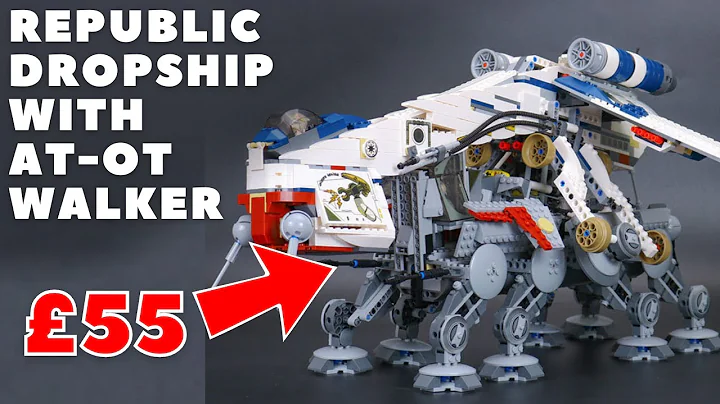Master the Art of Building Spaceships with Prosperous Universe
Table of Contents
- Introduction
- The Complexities of Building a Spaceship
- The Role of Third-Party Services and Retailers
- The Reality of Manufacturing Goods
- The Case of NASA's Saturn 5
- The Logistics of Sourcing Components
- The Challenges of Building a Rocket from Scratch
- The Interlocking Ecosystem of Manufactured Goods
- Pros and Cons of Building from Existing Plans
- Introducing Prosperous Universe
- The Concept of Prosperous Universe
- Gameplay in Prosperous Universe
- Realistic Elements in Prosperous Universe
- Comparing Prosperous Universe to Other Games
- Tailoring Your Experience in Prosperous Universe
- Conclusion
Building Spaceships: Navigating the Complexities of Manufacturing
Introduction
Building a spaceship is an endeavor that requires meticulous planning, precise engineering, and strategic collaboration. While we may be familiar with the manufacturers of iconic vessels like the YT-1300 series and the Enterprise D, we often overlook the intricate web of suppliers and service providers that contribute to the construction process. In this article, we will delve into the complexities of building spaceships, exploring the role of third-party services and retailers, the challenges faced by organizations like NASA, and the interlocking ecosystem of manufactured goods. Additionally, we will introduce Prosperous Universe, a browser-based space economy MMO that offers players a unique opportunity to immerse themselves in the world of interstellar commerce.
The Complexities of Building a Spaceship
Whether it's a small spacecraft or a colossal rocket, the construction of a spaceship is no small feat. It involves a multitude of processes, ranging from designing and assembling the various components to ensuring their seamless integration. As outsiders, it's easy to overlook the sheer scope of work that goes into realizing a functioning spacecraft. It requires expertise from diverse fields, including engineering, materials science, electronics, and propulsion systems. Each aspect must be meticulously planned and executed to achieve the desired outcome.
The Role of Third-Party Services and Retailers
Often, the success of a spaceship project relies heavily on the availability of third-party services and retailers. These entities play a crucial role in supplying the necessary materials, components, and expertise required for the construction process. From sourcing rare metals and self-sealing stem bolts to providing cutting-edge propulsion systems, the contributions of these external entities are invaluable. Without their support, many spaceship projects would grind to a halt. However, effective collaboration and coordination become paramount to ensure smooth operations and timely delivery of components.
The Reality of Manufacturing Goods
Manufactured goods, including spaceships, do not exist in isolation. They are part of a vast ecosystem of interrelated products, built upon each other to create the final outcome. The journey starts with raw resources, which are transformed into components and sub-assemblies, eventually coming together to form the end product. This intricate web of manufacturing involves numerous companies, each specializing in a specific area of expertise. It is this collaborative effort that enables the creation of complex vehicles like spaceships.
The Case of NASA's Saturn 5
To illustrate the intricate nature of manufacturing a spaceship, let's consider the iconic Saturn 5 rocket used in NASA's Apollo missions. While NASA possesses the plans and technical knowledge to build another Saturn 5, the challenge lies in sourcing the components. Many of the materials and technologies used in the original rocket are no longer manufactured. For instance, the launch vehicle digital computer of the instrument unit relied on a specific model of magnetic core memory that is no longer available. This means that even if NASA wanted to recreate the Apollo mission, they would need to either locate discontinued components or modify the plans to use modern alternatives.
The Logistics of Sourcing Components
Finding discontinued components becomes a daunting task when constructing a spaceship. Sometimes, certain critical elements, such as specialized screws or specific alloys, are no longer produced. This necessitates searching through alternative suppliers, salvaging from existing spacecraft, or making design modifications to accommodate available components. The process becomes even more complex when considering the adherence to safety standards, reliability, and compatibility of the substitute parts. These logistical challenges can significantly impact project timelines and budgets.
The Challenges of Building a Rocket from Scratch
Given the difficulties involved in sourcing discontinued components, building a rocket from scratch often becomes a more viable option. While it may seem daunting, starting afresh allows for modern materials, technologies, and manufacturing processes to be incorporated. Designing a new spacecraft eliminates the dependence on rare or obsolete items, enabling engineers to optimize for efficiency, performance, and safety. However, this approach requires significant investments in research, development, and testing, making it a complex decision for organizations.
The Interlocking Ecosystem of Manufactured Goods
Spaceships, like any other manufactured goods, are part of an interconnected ecosystem. From the raw materials used to fabricate engine components to the intricate systems that support life in space, every element relies on a vast network of suppliers, manufacturers, and retailers. This ecosystem allows for constant innovation and improvement, as each entity builds upon the advancements made by others. Understanding this interconnectedness is crucial for comprehending the challenges faced in building spaceships.
Pros and Cons of Building from Existing Plans
Building from existing plans presents a unique set of advantages and disadvantages. While having a blueprint provides a head start in terms of designs and specifications, it heavily relies on the availability of components. As we've seen with the Saturn 5 example, discontinued or obsolete parts can pose significant obstacles. However, using existing plans also allows for the preservation of proven technologies and engineering expertise. It strikes a balance between innovation and pragmatism, leveraging past successes while incorporating modern advancements.
Introducing Prosperous Universe
Amidst the complexities of building spaceships, there exists a virtual universe where players can immerse themselves in the challenges and triumphs of interstellar commerce. Prosperous Universe, a browser-based space economy MMO developed by Simulogix, offers a unique gaming experience that combines meticulous strategy with immersive gameplay. In the following sections, we will explore the concept of Prosperous Universe, delve into its gameplay mechanics, and discuss how it stands apart from other similar games in the genre.
The Concept of Prosperous Universe
In Prosperous Universe, players assume control of a company on one of the many settled planets in a post-Earth diaspora society. The objective is to establish and expand economic operations, building the foundation for humanity's future expansion into new worlds. Players can choose their starting base and select a base job package, providing them with the necessary tools and resources to thrive in their chosen economic niche. The game's in-browser Apex interface offers a streamlined visual style and customizable line commands, giving players the flexibility to tailor their experience according to their business strategy.
Gameplay in Prosperous Universe
One of the highlights of Prosperous Universe is its ability to replicate the realities of living and working in space. Factors such as atmospheric conditions, gravity, and planetary characteristics influence the types and quantities of construction components required for building bases and structures. For example, constructing a base on a high-temperature rocky world would necessitate thermal shielding and specialized construction granulate. On the other hand, bases on frigid gas giants would require unique foundations to float within the planet's upper atmosphere. The game takes into account not only mass but also volume, ensuring a realistic representation of the challenges faced in space exploration and settlement.
Realistic Elements in Prosperous Universe
Unlike other games in its genre, Prosperous Universe leans more towards hard science fiction, incorporating realistic elements from various fields of science. From orbital mechanics dictating travel times to the considerations of supply and demand affecting market dynamics, the game strives to create a near-to-mid-future setting rooted in scientific plausibility. While certain aspects, such as FTL drives and sublight engines, are fictionalized for gameplay purposes, the overall experience offers a solid blend of realism and immersion.
Comparing Prosperous Universe to Other Games
Prosperous Universe distinguishes itself from other space-based games by focusing solely on the aspects of base building, production, and business management. Unlike games like EVE Online, Prosperous Universe does not feature space combat or player-driven conflict. Instead, it provides players with a sandbox environment where they can concentrate on expanding their economic enterprises without the constant threat of losing progress to unexpected attacks. This approach appeals to players who prefer a more peaceful and strategic gameplay experience, allowing them to play at their own pace.
Tailoring Your Experience in Prosperous Universe
One of the standout features of Prosperous Universe is its flexibility in catering to different playstyles. Whether you prefer a casual approach, tending to your crops and manufacturing basic ration packs in minimal time, or aspire to be a meticulous tycoon, overseeing complex supply chains and optimizing profit margins, the game offers you the freedom to choose. Whether you invest a few minutes or hours each day, Prosperous Universe allows you to shape your gameplay experience according to your personal preferences.
Conclusion
Building spaceships is a complex endeavor that relies on the collaboration of numerous stakeholders. The intricacies of sourcing components, managing supply chains, and integrating diverse technologies make it a challenging task. However, through games like Prosperous Universe, players can gain a deeper understanding of the intricate web that encompasses manufacturing and commerce in the vastness of space. With its realistic elements, immersive gameplay, and strategic flexibility, Prosperous Universe offers a unique gaming experience that appeals to enthusiasts of space economics and exploration.
Highlights
- Building a spaceship requires meticulous planning, precise engineering, and strategic collaboration.
- Third-party services and retailers play a crucial role in the success of spaceship projects.
- Manufacturing goods, including spaceships, are part of an interconnected ecosystem of suppliers and manufacturers.
- Sourcing discontinued components poses significant challenges in building spaceships.
- Building from existing plans offers a balance between innovation and reliance on proven technologies.
- Prosperous Universe is a browser-based space economy MMO that offers a unique gaming experience.
- Players in Prosperous Universe establish and expand economic operations on settled planets.
- The game replicates the realities of living and working in space, taking into account atmospheric conditions and planetary characteristics.
- Prosperous Universe incorporates realistic elements from various scientific fields for a near-to-mid-future setting.
- The game distinguishes itself by focusing on base building, production, and business management, without featuring player-driven conflict.
- In Prosperous Universe, players have the freedom to tailor their gameplay experience according to their preferences.



















